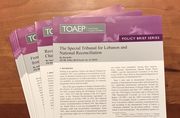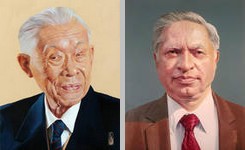Table of contents:
5. The perpetrator inflicted severe physical or mental pain or suffering upon one or more persons.
5.1.1. Evidence of infliction, by act or omission, of physical pain or suffering.
5.1.2. Evidence of infliction, by act or omission, of mental pain or suffering.
5.1.3. Evidence of infliction, by act or omission, of both physical and mental pain or suffering.
Element:
5. The perpetrator inflicted severe physical or mental pain or suffering upon one or more persons.
5.1.1. Evidence of infliction, by act or omission, of physical pain or suffering.
"Cruel and inhumane treatment has been defined in the jurisprudence of the Tribunal as "an intentional act or omission, that is an act which, judged objectively, is deliberate and not accidental, which causes serious mental or physical suffering or injury or constitutes a serious attack on human dignity" and includes such offences as torture."[1]
According to the Trial Chamber in Mucić et al. ("Čelebići")
"The foregoing facts demonstrate that Dragan Kuljanin was subjected to deliberate ill treatment on numerous occasions during his detention in the Mucić et al. Čelebići prison-camp. The Trial Chamber finds that the beatings described above caused Mr. Kuljanin serious suffering and physical injury. Accordingly, with respect to each separate act of ill-treatment found above, the Trial Chamber finds that the offences of wilfully causing great suffering or serious injury to body or health under Article 2, and cruel treatment under Article 3 of the Statute, have been proven beyond a reasonable doubt."[2]
According to the Trial Chamber in Ntagerura et al.,
"The Chamber has found that, on 11 April 1994, soldiers arrested at least seven refugees, including Witness LI, near Cyangugu Cathedral and took them to the Kararnbo military camp in Cyangugu, as alleged in paragraph 3.20 of the indictment. [...] The soldiers repeatedly kicked and beat the refugees, including with the buns of their rifles, from the time of their arrest and through their incarceration at the camp. [...] During their incarceration at the camp, soldiers beat the detainees again with wooden sticks and rifle butts while threatening to beat them to death." "[3]
5.1.2. Evidence of infliction, by act or omission, of mental pain or suffering.
5.1.3. Evidence of infliction, by act or omission, of both physical and mental pain or suffering.
According to the Trial Chamber in Mucić et al. ("Čelebići")
"Accordingly, the Trial Chamber finds that the detainees in the Čelebići prison-camp were exposed to conditions in which they lived in constant anguish and fear of being subjected to physical abuse. Through the frequent cruel and violent deeds committed in the prison-camp, aggravated by the random nature of these acts and the threats made by guards, the detainees were thus subjected to an immense psychological pressure which may accurately be characterised as 'an atmosphere of terror'."[4]
"The Trial Chamber also finds that there is sufficient evidence to establish beyond reasonable doubt that the brutal separation of the men from the women and children throughout the Potočari area on 12 and 13 July amounts to cruel and inhumane treatment. The Trial Chamber finds that the refugees who experienced the pulling apart of their families - who were aggressively separated and taken away from their beloved ones without knowing if they would ever see them again - suffered serious mental harm. As one example of an extremely aggressive separation that also caused serious bodily harm, the Trial Chamber recalls the evidence that a young boy was grabbed by the throat and "more or less strangled" when a VRS soldier tried to pull him away from his family."[5]
5.1.4. The severity of the pain or suffering inflicted.
The Kvočka et al. Trial Chamber held that:
"In assessing the degree of harm required for an offence to qualify as cruel treatment, consideration should be given to the object and purpose of Common Article 3, which attempts to delineate a minimum standard of treatment to be afforded to persons taking no active part in the hostilities."[6]
"a precise threshold for determining what degree of suffering is sufficient to meet the definition of torture has not been delineated. In assessing the seriousness of any mistreatment, the Trial Chamber must first consider the objective severity of the harm inflicted. Subjective criteria, such as the physical or mental effect of the treatment upon the particular victim and, in some cases, factors such as the victim's age, sex, or state of health will also be relevant in assessing the gravity of the harm"[7]
"Damage to physical or mental health will be taken into account in assessing the gravity of the harm inflicted. The Trial Chamber notes that abuse amounting to torture need not necessarily involve physical injury, as mental harm is a prevalent form of inflicting torture. For instance, the mental suffering caused to an individual who is forced to watch severe mistreatment inflicted on a relative would rise to the level of gravity required under the crime of torture. Similarly, the Furundžija Trial Chamber found that being forced to watch serious sexual attacks inflicted on a female acquaintance was torture for the forced observer. The presence of onlookers, particularly family members, also inflicts severe mental harm amounting to torture on the person being raped."[8]
"Finally, it should also be noted that the Special Rapporteur on Torture, in his 1986 report, provided a detailed, although not exhaustive, catalogue of those acts which involve the infliction of suffering severe enough to constitute the offence of torture, including: beating; extraction of nails, teeth, etc.; burns; electric shocks; suspension; suffocation; exposure to excessive light or noise; sexual aggression; administration of drugs in detention or psychiatric institutions; prolonged denial of rest or sleep; prolonged denial of food; prolonged denial of sufficient hygiene; prolonged denial of medical assistance; total isolation and sensory deprivation; being kept in constant uncertainty in terms of space and time; threats to torture or kill relatives; total abandonment; and simulated executions."[9]
"it is difficult to articulate with any degree of precision the threshold level of suffering at which other forms of mistreatment become torture. However, the existence of such a grey area should not be seen as an invitation to create an exhaustive list of acts constituting torture, in order to neatly categorise the prohibition. As stated by Rodley, "... a juridical definition cannot depend upon a catalogue of horrific practices; for it to do so would simply provide a challenge to the ingenuity of the torturers, not a viable legal prohibition."[10]
"the degree of physical or mental suffering that is required for inhumane treatment and cruel treatment is lower than the degree required for torture, though at the same level as the degree required to prove a charge of "wilfully causing great suffering or serious injury to body or health"[11]
"Torture is constituted by an act or an omission giving rise to "severe pain or suffering, whether physical or mental", but there are no more specific requirements which allow an exhaustive classification and enumeration of acts which may constitute torture. Existing case-law has not determined the absolute degree of pain required for an act to amount to torture." "[12]
The Trial Chamber in Mrkšić et al.held that:
"Assessment of whether the acts charged as torture inflict severe pain or suffering will be made in light of all the circumstances of the case. These include the nature and context of the infliction of pain, the premeditation and institutionalization of the ill-treatment, the physical condition of the victim, the manner and the method used and the position of inferiority of the victim, the physical or mental effect of the treatment on the victim, the victim's age, sex, and state of health, and whether the mistreatment occurred over a prolonged period of time. There is no requirement that the act or omission has caused a permanent injury, or a physical injury as such, as mental harm is recognised as a prevalent form of torture. Further, it is now settled in the jurisprudence of the Tribunal that the perpetrator need not have acted in an official capacity."[13]
In Martić, the Trial Chamber stated that:
"The pain and suffering inflicted during acts of torture is more severe than the pain and suffering inflicted during other forms of mistreatment and cruel treatment. The Trial Chamber will assess on a case-by-case basis whether the acts or omissions charged as torture, inflicted severe physical or mental pain or suffering on the part of the victim.143 In its assessment of the severity of the pain or suffering inflicted, the Trial Chamber may take several factors into account, including the duration of the suffering inflicted, the nature of the crimes, the physical or mental condition of the victim, the effect of the acts on the victim, the victim's age, and the victim's position of inferiority to the perpetrator."[14]
"In the jurisprudence of the Tribunal several acts have been listed as rising to the level of seriousness necessary to constitute torture. These acts include beatings, administering electric shocks, forcing victims to watch executions of others, rape, forcing victims to bury the bodies of their neighbours and friends, and causing burn injuries."[15]
About the prohibited purposes, the Mucić et al. Trial Chamber stated:
"Another critical element of the offence of torture is the presence of a prohibited purpose. As previously stated, the list of such prohibited purposes in the Torture Convention expands upon those enumerated in the Declaration on Torture by adding 'discrimination of any kind'. The use of the words 'for such purposes' in the customary definition of torture, indicate that the various listed purposes do not constitute an exhaustive list, and should be regarded as merely representative. Further, there is no requirement that the conduct must be solely perpetrated for a prohibited purpose. Thus, in order for this requirement to be met, the prohibited purpose must simply be part of the motivation behind the conduct and need not be the predominating or sole purpose."[16]
"A fundamental distinction regarding the purpose for which torture is inflicted is that between a 'prohibited purpose' and one which is purely private. The rationale behind this distinction is that the prohibition on torture is not concerned with private conduct, which is ordinarily sanctioned under national law. In particular, rape and other sexual assaults have often been labelled as 'private', thus precluding them from being punished under national or international law. However, such conduct could meet the purposive requirements of torture as, during armed conflicts, the purposive elements of intimidation, coercion, punishment or discrimination can often be integral components of behaviour, thus bringing the relevant conduct within the definition. Accordingly,'[o]nly in exceptional cases should it therefore be possible to conclude that the infliction of severe pain or suffering by a public official would not constitute torture ... on the ground that he acted for purely private reasons.'"[17]
The Mucić et al. Trial Chamber added:
"As noted above, the Defence argues that an act can only constitute torture if it is committed for a limited set of purposes, enumerated in the Commentary to article 147 of the Fourth Geneva Convention. This proposition does not reflect the position at customary law as discussed above, which clearly envisages prohibited purposes additional to those suggested by the Commentary."[18]
"The purpose of these rapes was to intimidate, coerce and punish Ms. Antic. Further, at least with respect to the first rape, Delic's purpose was to obtain information from Ms. Antic, as it was committed in the context of:
"interrogation. In addition, the violence suffered by Ms. Antic in the form of rape, was inflicted upon her by Delic because she is a woman. As discussed above, this represents a form of discrimination which constitutes a prohibited purpose for the offence of torture."[19]
According to the Trial Chamber in Mucić et al. ("Čelebići")
"Nedeljko Draganić himself testified that on one occasion towards the end of June or beginning of July 1992, while he was confined in the Čelebići prison-camp, Esad Landžo and three other guards took him to another hangar, where they tied his hands to a beam in the ceiling and started hitting him with wooden planks and rifle butts, while asking him disclose where a rifle, which they believed him to own, was hidden, and during which he fainted two or three times. Thereafter, he was beaten almost every day by Esad Landžo, usually with a baseball bat and he was also forced, along with other detainees, to drink urine from the area where they were taken to urinate. On another occasion, Mr. Draganić testified that Esad Landžo took him to the same building and made him sit on the floor, against the wall, with his legs close together. Mr. Landžo then poured some gasoline on the lower part of his trousers and set them alight. As a consequence, his legs were badly burnt and, for lack of subsequent medical attention, the blisters caused by the burning became septic, requiring him to be taken to the so-called infirmary in Building 22 for treatment about a week later[38]... All of these abovementioned forms of mistreatment clearly caused serious mental and physical suffering to the victim and there is, therefore, enough reliable evidence available on the record to substantiate the charges of wilfully causing great suffering or serious injury to body or health, and the cruel treatment of, Nedeljko Draganić, contained in counts 36 and 37 of the Indictment."[20]
"the prohibited purpose need be neither the sole nor the main purpose of inflicting the severe pain or suffering."[21]
"[I]t must aim at obtaining information, or a confession, or at punishing, intimidating, humiliating or coercing the victim or a third person, or at discriminating, on any ground against the victim or a third person"[22]
"the Trial Chamber considers that among the possible purposes of torture one must also include that of humiliating the victim. This proposition is warranted by the general spirit of international humanitarian law: the primary purpose of this body of law is to safeguard human dignity. The proposition is also supported by some general provisions of such important international treaties as the Geneva Conventions and Additional Protocols, which consistently aim at protecting persons not taking part, or no longer taking part, in the hostilities from 'outrages upon personal dignity'. The notion of humiliation is, in any event close to the notion of intimidation, which is explicitly referred to in the Torture Convention's definition of torture."[23]
"On the other hand, three elements remain contentious:
"(i) The list of purposes the pursuit of which could be regarded as illegitimate and coming within the realm of the definition of torture [...]"[24]
The Chamber then concluded:
"The Trial Chamber is satisfied that the following purposes have become part of customary international law: (a) obtaining information or a confession, (b) punishing, intimidating or coercing the victim or a third person, (c) discriminating, on any ground, against the victim or a third person. There are some doubts as to whether other purposes have come to be recognised under customary international law." "[25]
"The act or omission must aim at obtaining information or a confession, or at punishing, intimidating or coercing the victim or a third person, or at discriminating, on any ground, against the victim or a third person."[26]
The Trial Chamber in the Haradinaj and al. retrial held that:
"Torture [...] aims, through the infliction of severe mental or physical pain, to attain a certain result or purpose. This includes, albeit not exhaustively, the purpose to obtain information or a confession, to punish, intimidate or coerce the victim or a third person, or to discriminate, on any ground, against the victim or a third person. In the absence of these purposes or goals, even very severe infliction of pain would not be classified as torture."[27]
"The Chamber defines the essential elements of torture as :
(i) The perpetrator must intentionally inflict severe physical or mental pain or suffering upon the victim for one or more of the following purposes:
(a) to obtain information or a confession from the victim or a third person;
(b) to punish the victim or a third person for an act committed or suspected of having been committed by either of them;
(c) for the purpose of intimidating or coercing the victim or the third person;
(d) for any reason based on discrimination of any kind.
"(ii) The perpetrator was himself an official, or acted at the instigation of, or with the consent or acquiescence of, an official or person acting in an official capacity."[28]
According to the Trial Chamber in Ntagerura et al.,
"The Chamber has found that soldiers under Imanishimwe's effective control and in his presence severely beat Witness MG and another detainee and hammered a long nail into the foot of one detainee, removed the nail, and hammered it into the foot of another detainee while questioning them whether they were members of the RPF and accusing them of collaborating with the enemy. [...]"[]"[]
"On the basis of the foregoing, the Chamber finds that, in mistreating Witness MG and the other three detainees, the soldiers were acting intentionally and with the aim of obtaining information or confessions from the detainees or punishing them. Additionally, the Chamber finds that the severe beating and mistreatment with the long nail amounted to infliction of severe physical pain. Consequently, the Chamber finds beyond a reasonable doubt that this mistreatment constituted torture within the scope of Article 4(a) of the Statute."[29]
Footnotes:
[1] ICTY, Krstić Trial Judgment, 02 August 2001, para. 516.
[2] ICTY, Mucić et al. ("Čelebići") Trial Judgment, 16 November 1998, para. 1034.
[3] ICTR, Ntagerura et al. Trial Judgment 25 February 2004, para. 786.
[4] ICTY, Mucić et al. ("Čelebići") Trial Judgment, 16 November 1998, para. 1091.
[5] ICTY, Jokić Trial Judgment, 17 January 2005, para. 607.
[6] ICTY, Kvočka et al. Trial Judgment, 2 November 2001, para. 160.
[7] ICTY, Kvočka et al. Trial Judgment, 2 November 2001, para. 143.
[8] ICTY, Kvočka et al. Trial Judgment, 2 November 2001, para. 149.
[9] ICTY, Mucić et al. Trial Judgment, 16 November 1998, para. 467.
[10] ICTY, Mucić et al. Trial Judgment, 16 November 1998, para. 469.
[11] ICTY, Prosecutor v. Naletilić and Martinović ("Tuta and Štela"), "Judgment", IT-98-34-T, 31 March 2003.
[12] ICTY, Prosecutor v. Kunarac, Kovac and Vukovic, "Appeals Judgement", IT-96-23-T and IT-96-23/1-A, 12 June 2002, para. 149.
[13] ICTY, Mrkšić et al. Trial Judgment 27 September 2007 para. 514.
[14] ICTY, Martić Trail Judgment 12 June 2007 para. 75.
[15] ICTY, Martić Trail Judgment 12 June 2007 para. 76.
[16] ICTY, Mucić et al. ("Čelebići") Trial Judgment, 16 November 1998, para. 470.
[17] ICTY, Mucić et al. Trial Judgment, 16 November 1998, para. 471.
[18] ICTY, Mucić et al. ("Čelebići") Trial Judgment, 16 November 1998, para. 472.
[19] ICTY, Mucić et al. Trial Judgment, 16 November 1998, para. 963.
[20] ICTY, Mucić et al. ("Čelebići") Trial Judgment, 16 November 1998, para. 1018.
[21] ICTY, Kvočka Trial Judgment, 2 November 2001, para. 153.
[22] ICTY, Furundžija Appeal Judgment, 21 July 2000, para. 111, See also ICTY, Furundžija Trial Judgment, 10 December 1998, para. 162.
[23] ICTY, Furundžija Trial Judgment, 10 December 1998, para. 162. (footnotes omitted).
[24] ICTY, Kunarac et al. Trial Judgment, 22 February 2001, para. 484.
[25] ICTY, Kunarac et al. Trial Judgment, 22 February 2001, para. 485.
[26] ICTY, Kunarac et al. Trial Judgment, 22 February 2001, para. 497.
[27] ICTY, Haradinaj et al. Trial Judgment , 29 November 2012, para. 418.
[28] ICTR, Akayesu Trial Judgment, 2 September 1998, para. 594.
[29] ICTR, Ntagerura et al. Trial Judgment 25 February 2004, para. 796-797.







